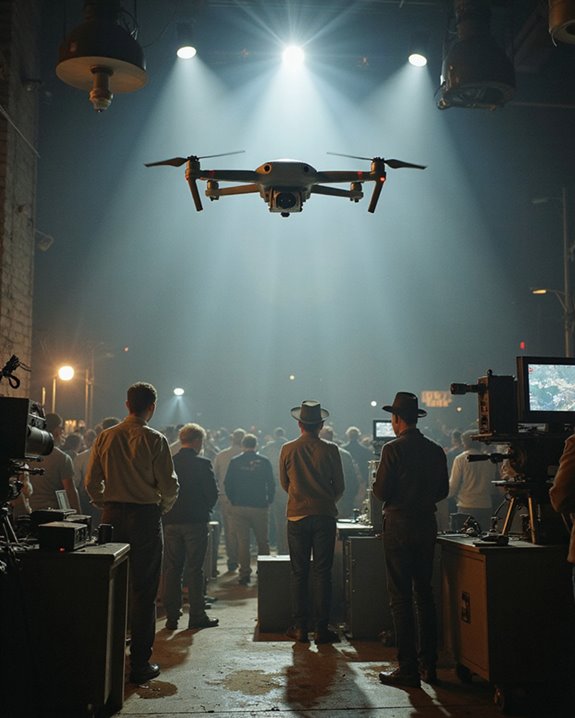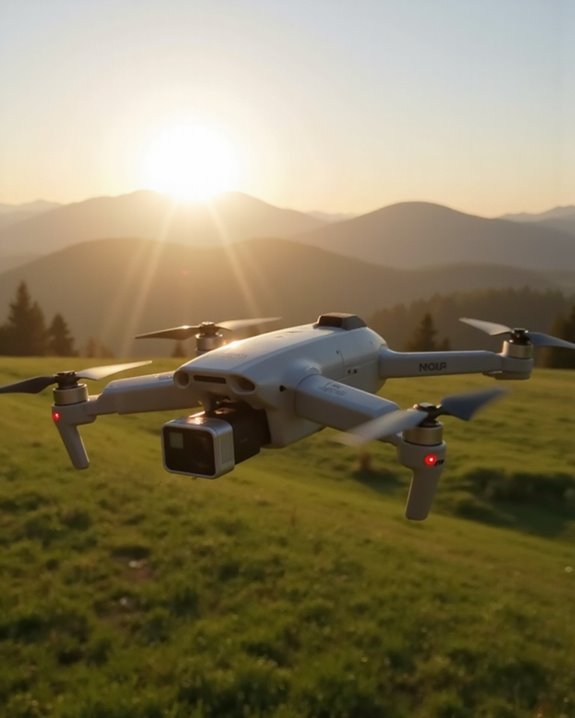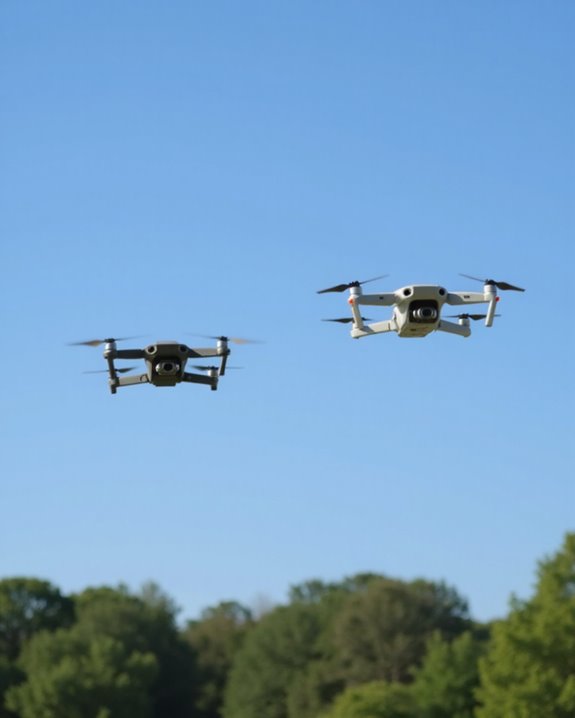Drones first soared into filmmaking in the early 2010s, adding energy and fresh perspective to big movies like “Skyfall” and “The Wolf of Wall Street”—imagine buzzing above rooftops, not stuck in a wobbly helicopter! While military drones existed much earlier, Hollywood really got serious after the FAA approved their use in 2014, allowing directors to capture those jaw-dropping aerial shots safely and legally. There’s a fascinating story behind this flying revolution, just waiting to be uncovered next!
Key Takeaways
- Drones were first used in filmmaking in the early 2010s for aerial shots previously captured by helicopters or cranes.
- “Skyfall” (2012) is one of the earliest major films to use drones for dynamic chase and aerial scenes.
- Widespread industry adoption began after the FAA granted approval for commercial drone filming in September 2014.
- Early drone filming required special permits and strict regulations before broader legal acceptance.
- Drones revolutionized cinematic techniques by enabling sweeping, immersive shots at lower costs and with greater flexibility.
Early Experimentation and Military Origins
When you think of drones today, you probably picture tiny buzzing machines capturing cool aerial shots for blockbuster movies, but their story actually begins in the smoky chaos of World War I! Back then, WWI Prototypes like Archibald Low’s 1916 models and Max Boucher’s pilotless Voisin plane—flying over 500 meters in 1917—were military innovations designed for spying instead of filming epic car chases. The military needed safer ways to peek behind enemy lines, so these early drones did the dangerous work. Even though their technology was pretty basic, they proved pilotless flight was possible, sparking decades of development. Every wild drone shot you see in movies owes a debt to these first, clunky flying machines, built for war, not Hollywood glamour!
Legal Barriers and International Workarounds
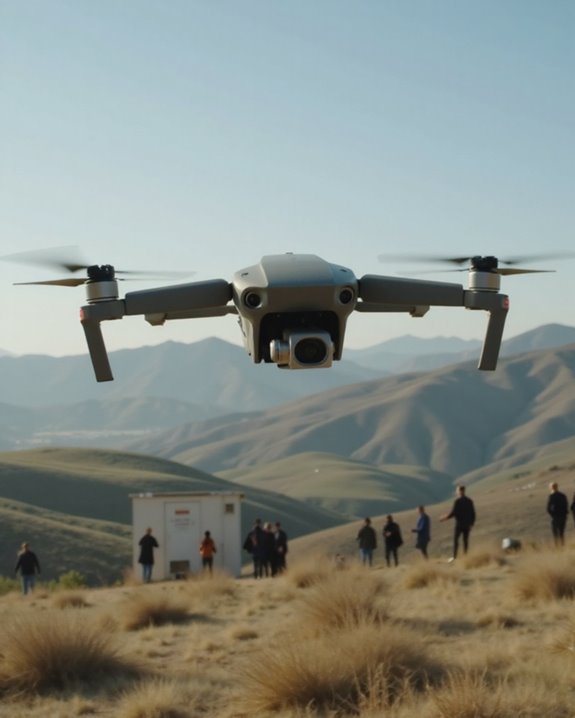
Long before Hollywood directors could shout “action!” and send drones soaring over city skylines, filmmakers faced a maze of rules that could make even the bravest action hero sweat. Privacy Ethics quickly became a big deal—imagine accidentally filming someone’s backyard barbecue during a car chase scene! Directors needed drone registration, special permits, and Remote Pilot Certificates just to get started. Filming in different countries meant learning new laws, dealing with flight restrictions, and sometimes even hiring local crews to avoid trouble. Insurance Strategies were essential, too, protecting productions from privacy lawsuits or accidental property damage. Regulatory compliance services, legal consultants, and technology customized for local standards helped filmmakers jump legal hurdles, all while trying to respect cultural norms and keep those incredible shots rolling. Additionally, many drones under 249g were favored for filming because they avoid FAA registration, simplifying legal processes for filmmakers.
The Turning Point: FAA Approval in 2014

A major shift in the world of filmmaking soared onto the scene on September 25, 2014, and it wasn’t just another blockbuster premiere—this was the day the Federal Aviation Administration finally gave the green light to drones in Hollywood. Suddenly, six lucky production companies could fly unmanned aerial systems over closed sets, as long as they followed strict rules. Want to shoot at night? Not so fast—Daytime Operations only! Any dreams of all-night drone filming had to wait for more safety data. And don’t forget those Battery Limits: each flight clocked out at 30 minutes, or sooner if the battery hit a 25% reserve. Filmmakers had to keep drones in sight, submit detailed activity plans, and make sure everyone stayed at least 100 feet away—safety first! Modern drone technology, including features like electronic image stabilization, has since enhanced the quality and stability of aerial footage in filmmaking.
Landmark Films Showcasing Drone Technology

Step onto a movie set today, and you might hear the gentle buzz of a drone before you spot the camera crew! Landmark films have embraced drone technology, wowing viewers and critics alike. Remember “Skyfall” (2012)? Its dynamic chase scenes, shot by drones, pulled audiences right into the action, boosting both excitement and audience engagement. “Jurassic World” (2015) used drones to soar above dinosaurs, offering unforgettable, sweeping views that helped the film earn critical acclaim for its visuals. Even “The Wolf of Wall Street” (2013) captured wild party scenes from above, proving drones are not just for action flicks. As filmmakers discover new ways to use drones, movie magic—once limited by cranes or helicopters—feels more thrilling, immersive, and, sometimes, literally above the rest! Modern drones like the Holy Stone HS600, equipped with a 4K/30FPS camera and 2-axis gimbal, provide filmmakers with professional-quality aerial footage that enhances cinematic storytelling.
Evolution of Cinematic Techniques Through Drones

Imagine this: filmmakers once needed helicopters, cranes, or some serious acrobatics to capture those epic sweeping shots. Now, thanks to drones from companies like DJI and Parrot, Visual Aesthetics in movies have changed forever! Drones swoop through forests, soar above cityscapes, and plunge into canyons, letting directors experiment with Dynamic Framing that was once impossible—or just wildly expensive. Remember the battle scenes in *Baahubali: The Conclusion*? Drones helped create those jaw-dropping moments, blending special effects and real landscapes into stunning visuals. Directors can now shift camera angles in seconds, adding excitement and energy to action scenes or even quiet emotional moments. With drones, filmmakers—whether indie or Hollywood—can chase creative dreams, all while keeping the crew safe and the budget in check.
Regulatory Shifts and Industry Impact
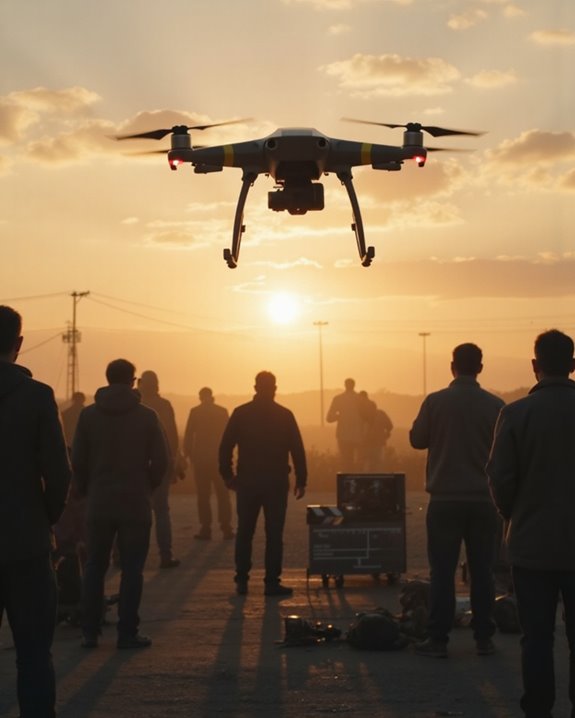
When drones first buzzed onto movie sets, filmmakers didn’t just have to worry about getting the perfect shot—they suddenly had to learn a whole new set of rules! In 2014, the FAA started granting exemptions for drones in film, and directors everywhere had to brush up on airspace laws. These regulatory shifts meant more paperwork, but also massive Economic Growth: drones made aerial shots cheaper, opened new revenue streams, and created jobs like “drone pilot” and “aerial cinematographer.” Safety Innovations were just as important—modern drones now sport obstacle detection, auto-landing features, and AI-driven navigation. Filmmakers also had to follow strict rules about where and how they could fly. It’s not just about creativity; it’s about safety, efficiency, and following the law!
The Ongoing Transformation of Filmmaking
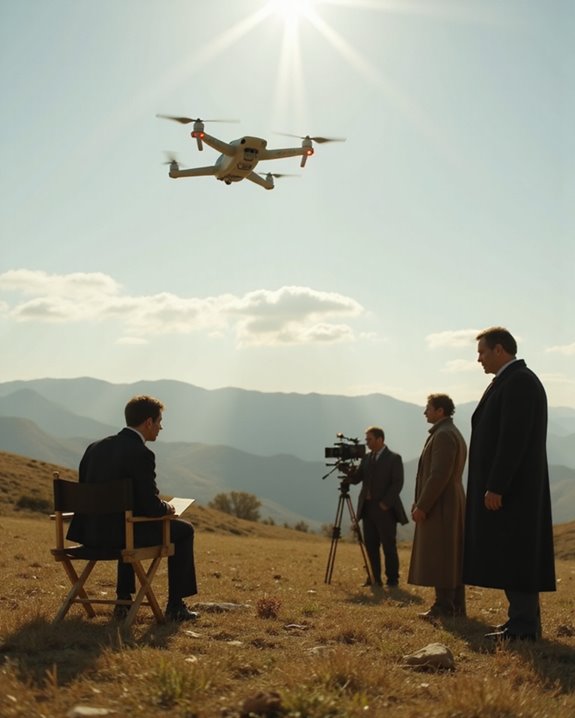
Transformation is the name of the game in modern filmmaking, and drones are leading the charge! With drones buzzing onto film sets, movies now soar to new creative heights—literally. Remember when *Skyfall* had just one drone shot? Now, drone footage is everywhere, from indie projects to blockbusters. The economic effects are pretty wild: drones slash costs by replacing pricey helicopters and cranes, making jaw-dropping aerial scenes accessible even to low-budget filmmakers. But, there’s more! Drones spark ethical implications, too, like respecting privacy and ensuring on-set safety. Filmmakers must balance innovation with responsibility, or risk some serious drama off-camera. As technology keeps evolving, drones aren’t just a trend—they’re reshaping film production, storytelling, and even the way audiences experience the magic of movies!
Frequently Asked Questions
What Types of Drones Are Most Commonly Used in Filmmaking Today?
Drone Varieties most commonly used in filmmaking today include quadcopters, hexacopters, and octocopters. Their Tech Features—such as high-resolution cameras, gimbal stabilization, and autonomous flight modes—enable filmmakers to capture smooth, cinematic aerial footage with enhanced creative flexibility.
How Do Filmmakers Ensure Drone Safety on Set?
Filmmakers guarantee drone safety on set by implementing risk assessments, battery safety protocols, weather protocols, and pre-flight checks. They use certified operators, conduct safety briefings, maintain line of sight, and establish emergency procedures to protect crew and equipment.
What Is the Average Cost of Renting a Filming Drone?
Average rental costs for filming drones can range from $3,000 to $10,000 per shoot. Cost variations depend on drone specifications and rental duration, greatly impacting production budgets and influencing filmmakers’ choices between basic and professional-grade drone setups.
Are There Special Training Requirements for Drone Operators in Film?
Special training requirements for drone operators in film include obtaining Training Certifications and passing License Exams, such as the FAA Part 107 license. Operators must also demonstrate proficiency in safety protocols, cinematography techniques, and regulatory compliance specific to filmmaking environments.
Can Drones Be Used for Indoor Filmmaking Scenes?
Nearly 60% of filmmakers now employ drones for indoor shoots, despite unique indoor challenges. Drones excel at capturing fluid camera movements, but operators must carefully manage lighting effects and obstacles to achieve professional, visually consistent footage in confined spaces.

